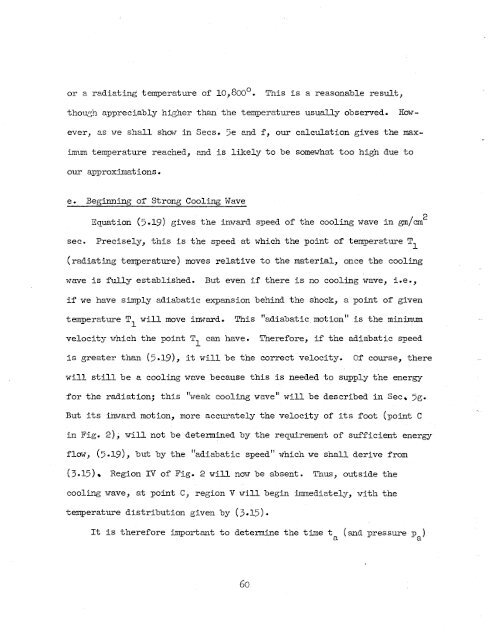Theory of the Fireball
Theory of the Fireball
Theory of the Fireball
Create successful ePaper yourself
Turn your PDF publications into a flip-book with our unique Google optimized e-Paper software.
or a radiating temperature <strong>of</strong> 10,800°. Tnis is a reasonable result,<br />
thowh appreciably higher than <strong>the</strong> teqeratures usually observed. How-<br />
ever, as we shall show in Secs. 5e md f, our calculation gives <strong>the</strong> max-<br />
imum temperature reached, md is likely to be somewhat too high due to<br />
OUT approxinmtions .<br />
e. Bewinning <strong>of</strong> Strow Coolim Wave<br />
2<br />
Equation (5 -19) gives <strong>the</strong> inward speed <strong>of</strong> <strong>the</strong> cooling wave in @/a<br />
sec. Precisely, this is <strong>the</strong> speed at which <strong>the</strong> point <strong>of</strong> teqerzhre T<br />
1<br />
(radiating temperature) moves relative to <strong>the</strong> material, once fne cooling<br />
wave is fully established. But even if <strong>the</strong>re is no cooling wave, i.e.,<br />
if we have simply adiabatic expansion behind <strong>the</strong> shock, a point <strong>of</strong> given<br />
temperature T1 will move intrzrd. This "adiabatic motion'' is <strong>the</strong> minimum<br />
velocity vlnich <strong>the</strong> point T can nave. Therefore, if tne adiabatic speed<br />
1<br />
is greater than (5.19) , it will be tne correct velocity. Of course, <strong>the</strong>re<br />
will still be a. cooling wave because this is needed to supply <strong>the</strong> energy<br />
for <strong>the</strong> radiation; tills 'be&< cooling wave" wil be described in Sec 5g.<br />
But its inward motion, more accurately <strong>the</strong> velocity <strong>of</strong> its foot (point C<br />
in Fig. 2), will not be determined by <strong>the</strong> requirement <strong>of</strong> sufficient energy<br />
flow, (3.19) , but by <strong>the</strong> "adiabatic speed" which we shall derive from<br />
(3.17) Region IV <strong>of</strong> Fig. 2 will nar be absent, Tnus, outside <strong>the</strong><br />
cooling wave, at point Cy region V wil begin Mediately, with <strong>the</strong><br />
temperature distribution given by (3.15).<br />
It is <strong>the</strong>refore important to determine <strong>the</strong> time ta (and pressme p )<br />
a<br />
60
















